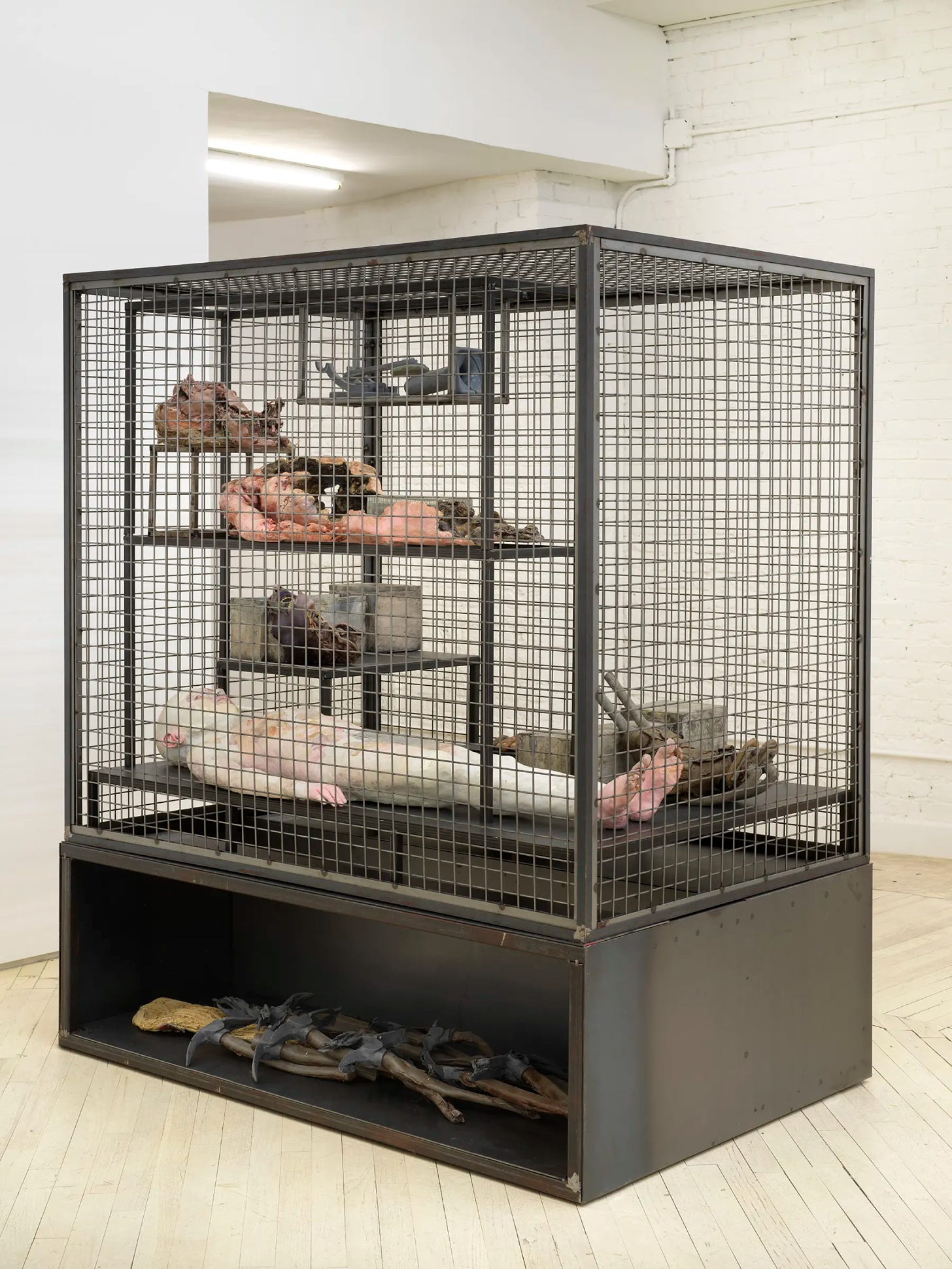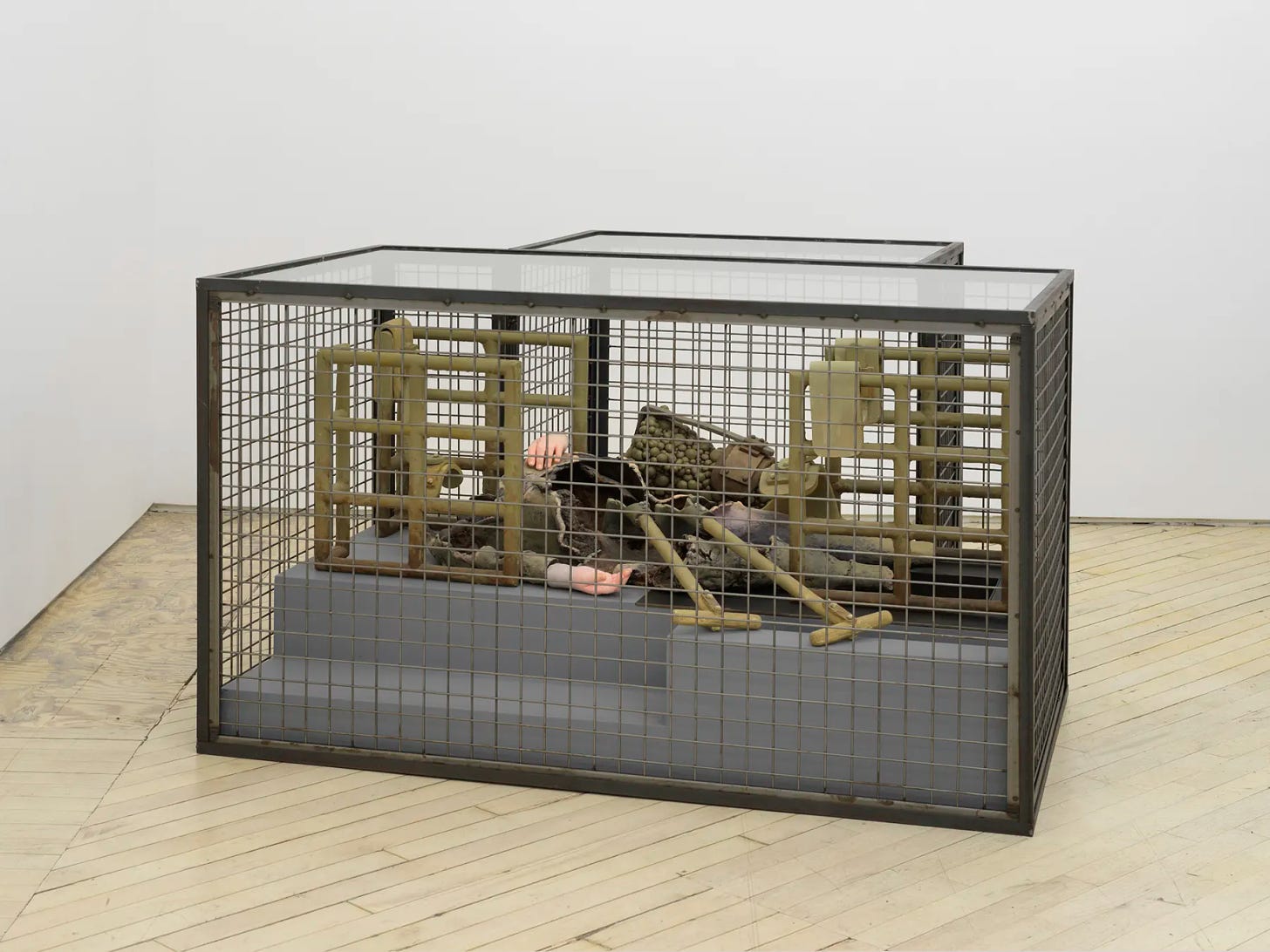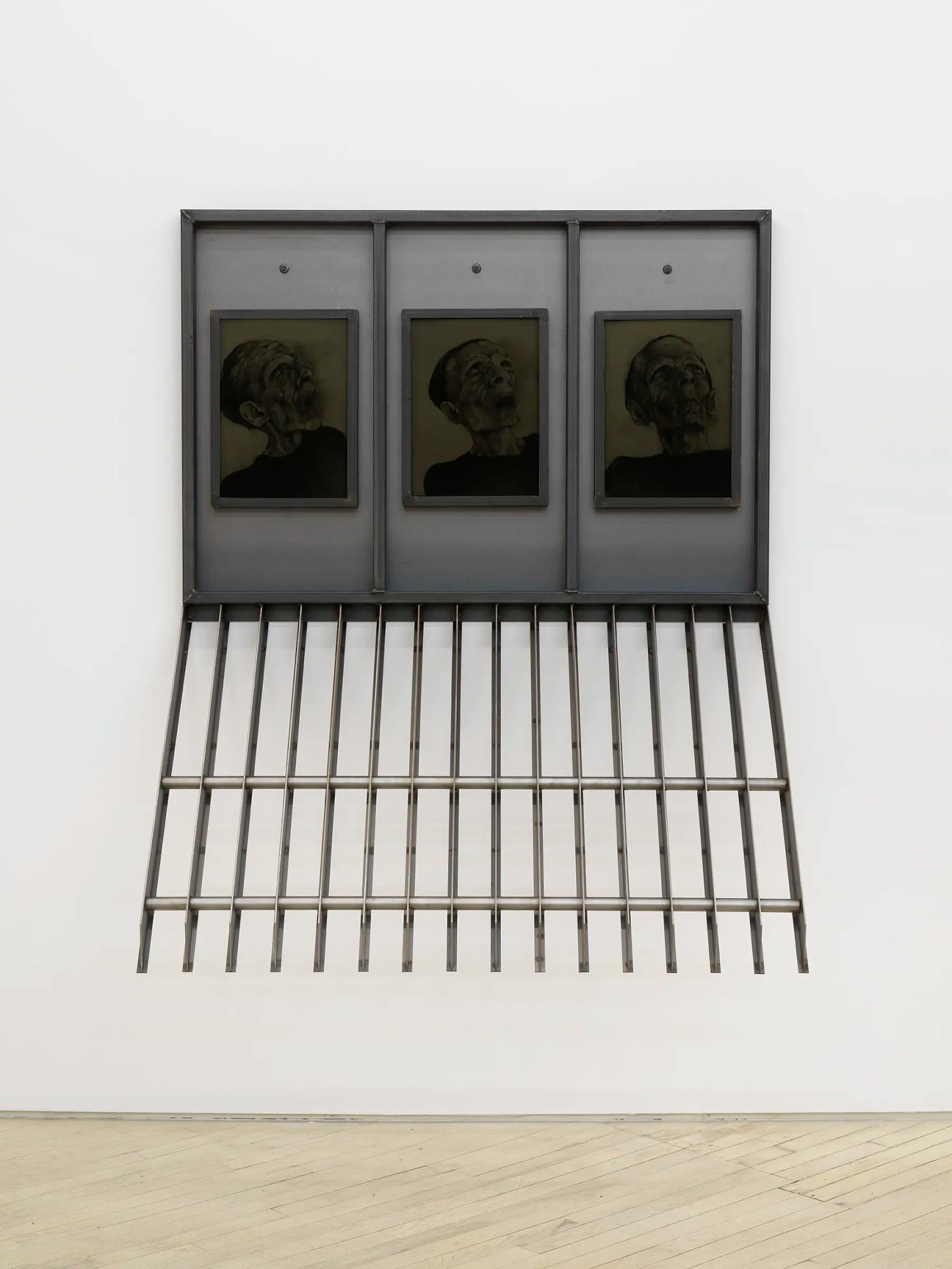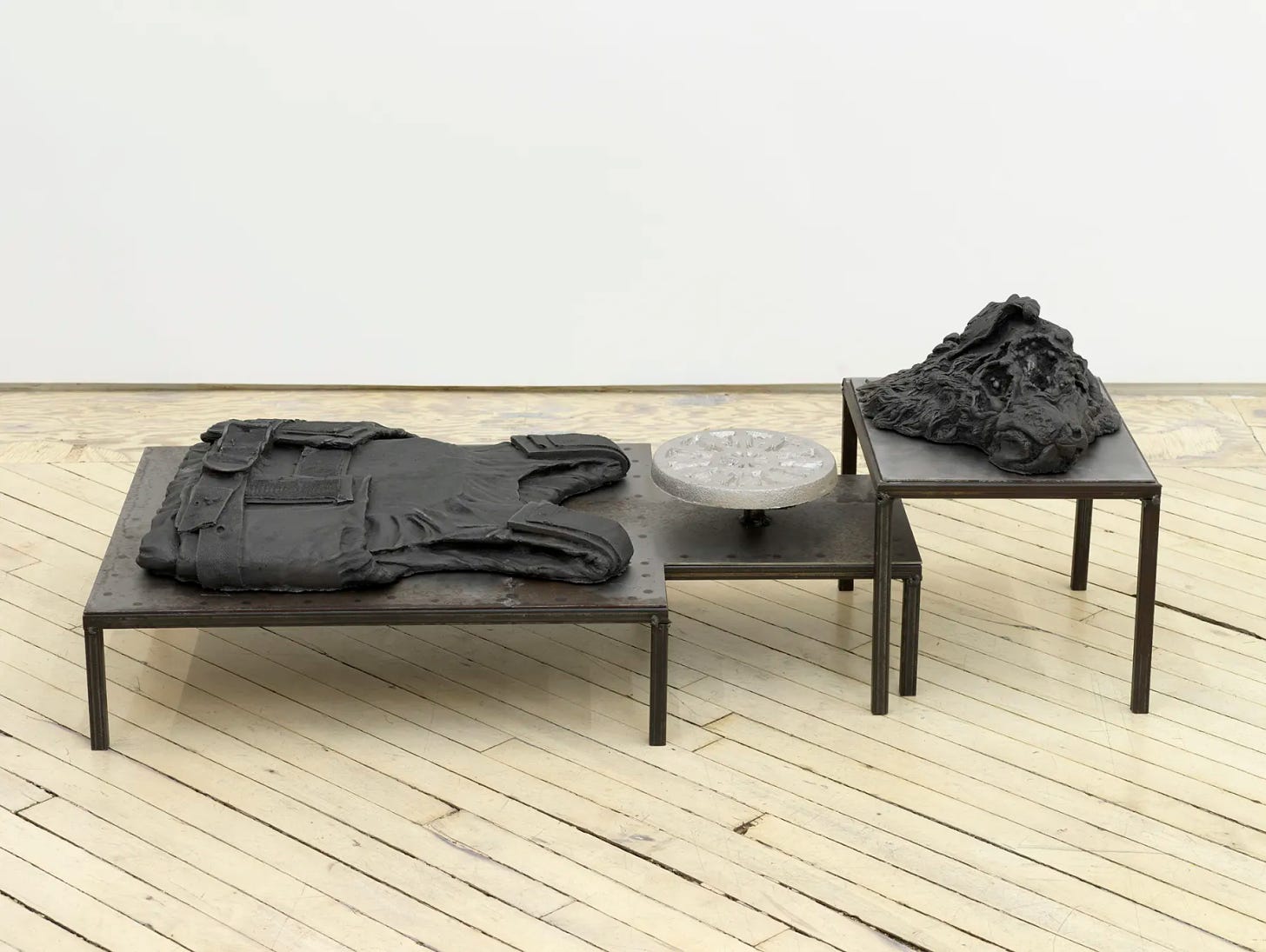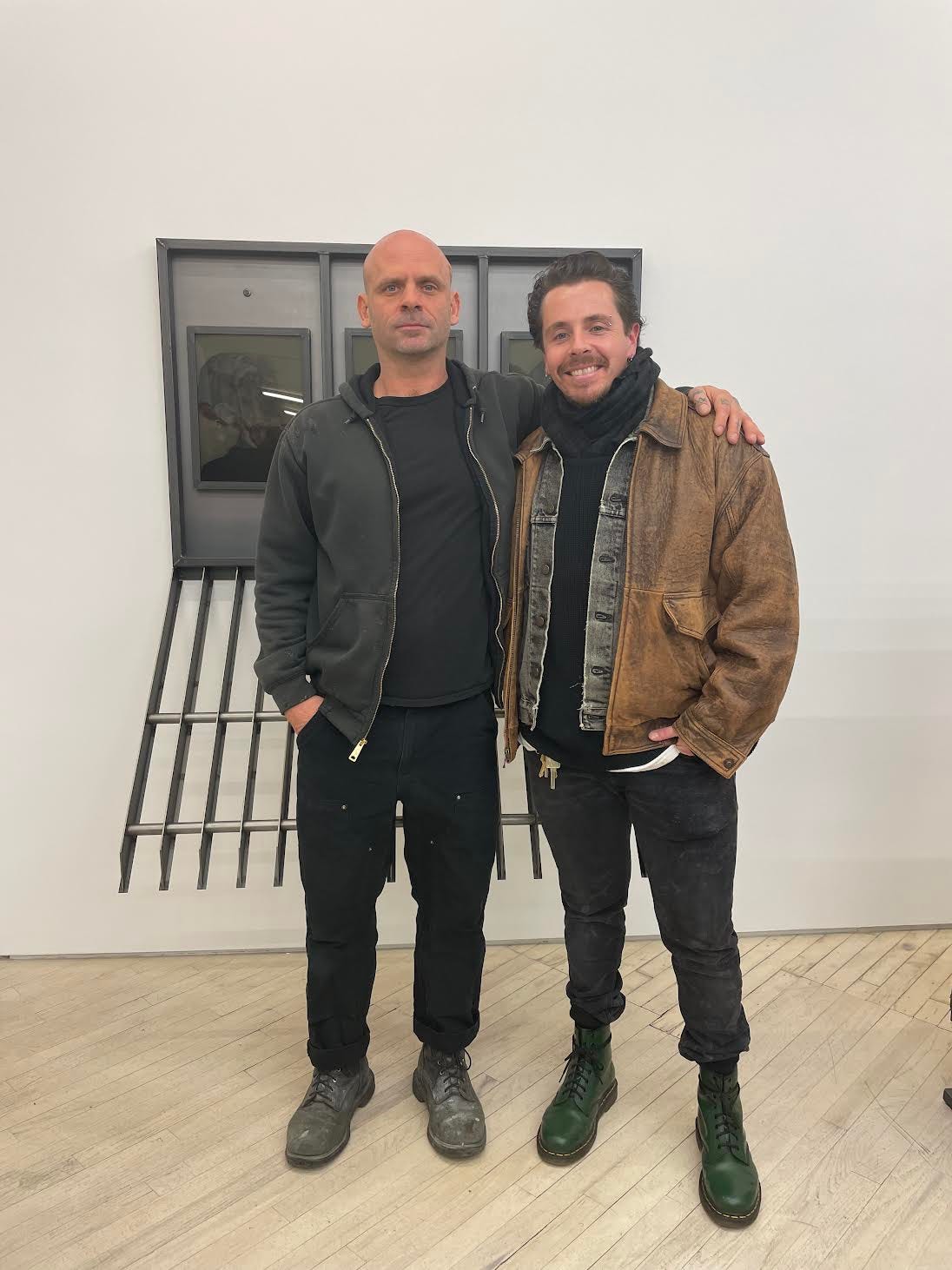Safety Propagandist #12: Lionel Maunz
The New York-based artist discusses his recent book collaboration with Peter Sotos and his current exhibition at Bureau Gallery
I was introduced to the artist Lionel Maunz’s work by a mutual friend, the artist Darja Bajagic, and immediately kicked myself for not having discovered it earlier. Truly, I was shocked that something like this even existed in or was shown by the contemporary art world. In complex and totalizing arrangements of sculptural works and pencil drawings evoking bodily dismemberments and various sufferings of the flesh, Lionel disregards sentiments of hollow moralism or humanism in favor of emotionally compelling and supremely potent conjurings of psychological complexity. The work really has to be seen in-person to understand its power. It’s a unique aesthetic experience that eradicates the boundaries between the subjectivity of the viewer and the intentionality of the art. With far more in common emotionally with religious art and classical sculpture than anything the art world foists on us today, it almost feels pre-conditional to discuss Lionel’s work in a vacuum, disconnected from anything else happening in contemporary art.
At the end of 2021, Philip Best’s Amphetamine Sulphate and Chip Smith’s Nine-Banded Books co-published a collaborative book between Maunz and the giant of inquisitive transgressive writing Peter Sotos. I read the book over the course of a couple weeks in February and was blown away. In it, Sotos uses images of Maunz’s works to form a dialectical relationship between the two artists as well as to create a kind of aesthetic theory in which Sotos explores the personal histories that have informed both artists’ confrontations with pain, suffering, pornography, violence, and otherwise. I’ve read Sotos for over a decade now and had already been deep in the exploration of Lionel’s art for some time (indeed, I wrote about Lionel’s work for my essay on Crypto-Transgression, also published by Amphetamine Sulphate in the Human Rights anthology), and yet, the book evolved and altered my understanding of both artists’ work in the most fascinating of ways. Many of Lionel’s works that I saw in the book are those that I’ve now seen in the flesh (pun intended) at his current show, Where the Body Ends, at Bureau Gallery. The exhibition is powerfully claustrophobic: a maximal arrangement of fleshly sculptures of disembodied human parts, some encased within glass and steel architectural structures, and several drawings of difficult and otherwise ambiguous images often emblazoned with various runic and talismanic symbols.
I am not going to say anymore about Lionel’s work. Why would I when I was able to commune with the man in question in the following interview? Alas, comrades, welcome Lionel to the Counter-Agency of the Avant-Garde.
Adam Lehrer: I remember when I came to your opening and I pointed at Nothing Inside you Was Real, one of my favorites in the show, and asked if the man depicted in the images was Artaud, as it reminded me of photos of Artaud as an older, totally insane and drug ravaged man. Instead, you corrected me that it was your father. Do you often use pieces of personal biography in the work? To what end does it function in the work?
Lionel Maunz: Yes, personal biography is essential in the work, it begins against me, I want the blade to cut both ways, on some level destroying origin. Still, I've always been suspicious of using one's biography when it can be used, in turn, by the viewer to excuse or worse apologize for one's decisions. It’s a lazy means of defaganging the work via the viewers inadequacies, ultimately a form of dismissal masquerading as interest.
Biography can provide too firm a footing, undeserved purchase for the viewer to insultingly understand (read denude) by reductively explaining away as some part of a cycle of violence and victimization. Grotesque being the implied holistic cycle not the violence.
That said, my current show, for better or worse, is a return to a more transparent mode of self-reflexiveness. For a number of years it was buried there for me alone. I got tired of concealment, to an extent tired of the sensitivity and calculation and ultimately tired of considering the viewers misunderstanding. I got sick of refusal as a structural concern and wanted to implicate myself more feverishly, work more impulsively. Looking for less restraint, to more clearly subsume myself in the hostility.
As an aside, I actually don't think Artaud was insane, as that both dismisses and qualifies him in the wrong ways. He was working with the absolute limits of body and language. That level of engagement, refusal and antagonistic desperation read maybe as insane only because he set himself to the impossible, denying the inadequacies of words and images, denying all stabilizing referent. The last and only thing he could do, ravaged by narcotics and literally fulminating psychiatry sure, but absolutely coherent and intentioned.
AL: I was watching an interview recently with the guys from the funeral doom band Skepticism. The interviewer kept trying to insist that there music was suicidal, and they pushed back and insisted that their work was, from their perspective, beautiful. And indeed, in my taste, brutality and beauty aren’t mutually exclusive. Your new show is, indeed, brutal, and yet awe-inspiring and even sublime. Are you often interested in where violence and beauty meet? Is that all an intention?
LM: First to mind is that beauty just isn't something I’m thinking about. It's just not the right word when excited or inflamed is the better option. It's the inadequacy of the word, violence also to a lesser extent, too umbrella’d into stand-ins for failed articulation, ultimately obscuring what they pretend to describe. They need contextual qualification. Violence has to mean real damage and beauty just doesn't work for me. Aesthetics are difficult when it just seems like the wrong conversation.
If I'm exhilarated by violence, by wounded flesh, if it turns me on or turns my stomach, if it terrifies, if it rarifies, beauty seems insufficient to describe the pull I’m navigating in the studio. I'm more interested in looking for ugliness and vehemence in physical violence, looking for instances where all the justifiables that balance and conceal are absent.
AL: I love that your art has a universality within it. It doesn’t evoke the suffering of any specific group, yet a more universal suffering about what it means to be a human and to be mortal. It gives the work a grandeur that I find absent from much contemporary art and associate more with art history, is this intentional?
LM: Actually, I would hope, particularly with this show, to evoke very specific suffering, pain only found in precise situations. But yeah, with the thematics of other shows - family, anti-natalism, Calvinism etc, the larger context is obviously there but the last thing I'm interested in is universality as an aim, which could never be anything other than pandering and populist. I don't care that everyone is damaged and terrified, my conversation is never connective. Quite the opposite, I'm trying to rarrify certain instances of exceptionalism.
Yes, generally I'm far more interested in historical art, broadly religious art, the Italian primitives, classical sculpture. I’m largely unengaged with contemporary art, I don't pay enough attention for obvious reasons. I’m hard on the arts, I’m looking for something that will overwhelm me, I want to love it completely, I want it to be a lash, to be jealous of it. There are of course a handful of contemporary exceptions to my general level of disinterest and disdain. First to mind is the exceptional Darja Bajagic, whose work I absolutely adore. We have a show together in November which I’m very excited about.
AL: The large class steel sculptures carry a true crime narrative – abductions perpetrated by Walter Priklopil and Marc Dutroux. What drew you to these cases?
LM: I appreciate you using the victimizers’ names rather than the victims, to introduce. Natascha and Sabine were given a voice solely by Walter and Marc. They only exist because of that damage.
It was less a choice than a progression. Everything in the studio is one thing leading to the next, hopefully escalating. Violence (that word again) against children has been a consistent subject in the studio and I wanted to cleanse away all other concerns and focuses, hoping to finally be done with it. That hasn't happened. A recurring theme. Thinking something can ever be exorcized rather than vortexed or just depleted. Thinking that I can ever fully leave alone or move beyond the things to which I’m captivated.
Both cases had the asymmetry necessary to purify physical and emotional violence into specifics. Both had the necessary subterranean, durational and inevitably sexual components that enthrall me, similarly the ugly desperation and decision.
Finally, the lacerating, still lived pain of both.
AL: Many of the pieces in the show I believe I had seen in the images in your book with Sotos, which I loved. The collaboration between the two of you made me see new things in both of your practices. Specifically, what about Sotos’ writing do you admire and what did you think could be interesting in collaborating together?
LM: Thanks man. The book. Fuck. We had been talking for years about doing something but the book was ultimately Pete's idea. He’s my favorite living author. You're asking why and honestly I don't know where to begin. Merciless, relentless, his work is a death march of scrutiny to insight that I’ve never experienced ever, anywhere. Drilling into the world. The sheer intensity of his contempt is staggering. Accommodating no one, giving no quarter, capitulating nothing, there’s such a rigorous discipline to the hostility, the likes of which I’ve only ever seen in the Bastille inflected fervor of Sade. I just hope my insistence on discipline here doesn’t obscure need.
Pete has completely consumed the holes in violence, pornography, aesthetics, intuition; exploded them into seething clarity. His words are in the world like a scalpel, a hammer, they are operational tools to butcher and render. His work is a puncturing, rupturing utility for me personally in his command of destructive lucidity.
There's a demand for experience lived, excoriating, contemptuous, that I've never felt so acutely, a brutality that I want to call astonishing before honest. These perfect wounds he leaves, so complete and final, honestly it’s both intimidating and deeply, deeply exciting. I hate my inadequacy in front of it.
AL: Given that your work does, in some sense, involve implied narratives, do you see your work in dialog with literature to any degree? Have there been writers whose work has inspired your work at all?
LM: Absolutely. Generally, I lean into literature and music before visual arts. But inspiration is a problematic word. It implies possession, some external force inhabiting. It sidelines the work one does to get to that position of relatability. These ideas of inspiration, the muse, creativity are repulsively inverted. They steal from the author. They are literally backwards. It's the work, the reading, the research one does that instigates the engagement. The language is inept and insulting, implying an unmoored state which is consolidated by some kind of external lightning, initiating the capability of saying something of worth.
Apologies for the digression, I just don't like the word inspire. Haha. But yes, good literature makes demands. Sotos, Sade, Laing, Sereny, Best, New Juche, Artaud, Mishima, Genet, Selby, Gira, Nietzsche, Junger, Dworkin. I’m most interested in those that don't need to be corrected and I try to deliver a response.
AL: I’ve been studying demon sigils and their meanings and such, so your use of talismanic imagery and rune shapes fascinates me. Were all of these chosen due to their actual meanings, or are you more drawn to them as neutral shapes? Are you interested in the idea of the occult seeping into your work?
LM: Yes, all actual meaning, nothing is neutral.
I am adamantly against the occult seeping into the work. I've done it in the past, originally as inversions of the symbology of my youth, intended as another level of negation. I'm interested in the occult when it’s destructive, the destruction it represents(the problem), the intent, but the practice is ludicrous and always evasive, an agreement to actually do nothing while feigning engagement. The occult is a cul de sac. But here they are again, symbols in the drawings, after years of disuse.
Around the same time I originally stopped using symbols, I was thinking about the power and authority of photography, wondering about its command of violence. I wanted to understand if and why certain images were as powerful as I thought they were. I wanted to give an exacting version of what I was responding to but now mine through the hours spent owning them. I had to invest myself to understand their potency. But again I got tired of this eventually rote transformation. So I brought symbols back into the work as a way of breaching the images, rupturing them, hoping for more. Cutting. Barbs, intentional against flesh. Devices used desperately, perhaps mistakenly to fracture, exacerbate and expand.
AL: An interesting if perhaps short-sighted essay on your work published by Glasstire seems to make much of your own personal backstory in light of the work and seems to hyper-focus on the sense of despair in your lexicon and imagery. While the despair is there, certainly, I also can’t help but see the incredible attention to detail and sheer craftsmanship involved in what you do as a sense of will to power, almost as if the power of the art is in conquering its own pessimism. Do you think art production can be a kind of seizing one’s own power and will?
LM: Thanks man, yes the despair is there but mostly used by the audience as a means of denigrating the work to an acceptable level of humanist enervation.
Cruelty and hatred are certainly a means to arrest despair. Artaud said cruelty is the fundamental necessity. Sade said it's the only thing left uncorrupted. Nietzsche said it's a residue, the excretion of power. So yes, I can't disagree with you. I use hatred against depression, while saying too much. It's all power and will.
“Without cruelty there is no festival.” Against reason, against one's inclinations, against the heart.
AL: People have a tendency to call any artist dealing with dismembered parts or psychological darkness as surreal, but I really don’t think it applies to your work. If anything, it’s a specific kind of hyper-realism that saturates it all. It almost reminds me of the writing of someone like Mikita Brottman or even Marco Corbelli’s work with his label and music as Atrax Morgue in that it is showing extremely unsettling aspects of reality that are suppressed, and thus the excavation and presentation of them creates its own peculiar uncanny. Do you think this is accurate at all? That repressed realism might be more unsettling than anything resembling surrealism?
LM: Agreed. I'm also suspicious of surrealism. I'm not trying to show anyone anything. There's no revelation. There is zero communication as it's generally understood. I’m not trying to change your mind, I dont fucking care what you think. This is a conversation with myself and a tiny handful of others. I'm really not trying to show ‘them’ anything, they just don't register. I wouldn't waste my time convincing. When I’m corrective, it's not for the audience. Surrealism is an exit, an opt out, a boring and sloppy gap in paying attention while pretending it's the exact opposite, it’s self-indulgent trust and relinquishment. I care too much about what I’m doing to get it that wrong, and probably haven't answered your question.
AL: You once said that your work is about the “unattainability between your excitement and your repulsion.” Do you think that your work is about trying to close that gap?
LM: Honestly, I'd say, I wish the gap was bigger.
Where the Body Ends is on view until April 16
IMAGES:
1. Lionel Maunz Where the Body Ends exhibition view
2. Lionel Maunz Where the Body Ends exhibition view
3. Lionel Maunz Catechism
4. Lionel Maunz Cavalry
5. Lionel Maunz Nothing Inside You Was Real
6. Lionel Maunz Eternal Winter
7. Lionel Maunz Love is the Law
8. Lionel and Adam bro’ing out






